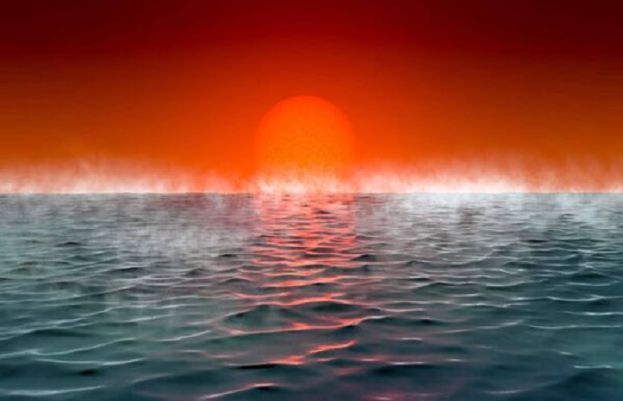Astronomers have observed a distant planet that could be entirely covered in a deep water ocean, in findings that advance the search for habitable conditions beyond Earth. The observations, by Nasa’s James Webb space telescope (JWST), revealed water vapour and chemical signatures of methane and carbon dioxide in the atmosphere of the exoplanet, which is twice Earth’s radius and about 70 light years away. This chemical mix is consistent with a water world where the ocean would span the entire surface, and a hydrogen-rich atmosphere, according to researchers from the University of Cambridge, although they do not envisage a balmy, inviting seascape. “The ocean could be upwards of 100 degrees [Celsius] or more,” said Prof Nikku Madhusudhan, who led the analysis. At high atmospheric pressure, an ocean this hot could still be liquid, “but it’s not clear if it would be habitable,” he added. This interpretation is favoured in a paper published in the journal Astronomy and Astrophysics Letters but is disputed by a Canadian team that made additional observations of the same exoplanet, which is known as TOI-270 d. They detected the same atmospheric chemicals but argue the planet would be too hot for liquid water – possibly 4,000C – and instead would feature a rocky surface topped by an incredibly dense atmosphere of hydrogen and water vapour. Whichever view wins out, these latest observations showcase the stunning insights James Webb is giving into the nature of planets beyond our solar system. The telescope captures the starlight that has been filtered through the atmospheres of orbiting planets to give detailed breakdowns of the chemical elements present. From this, astronomers can build up a picture of conditions at a planet’s surface – and the likelihood of life being able to survive there. The evidence for TOI-270 d’s ocean is based on the absence of ammonia, which basic chemistry predicts should occur naturally in a hydrogen-rich atmosphere. But ammonia is highly soluble in water and so would be depleted in the atmosphere if there were an ocean down below. “One interpretation is that this is a so-called ‘hycean’ world – with a water ocean under a hydrogen-rich atmosphere,” said Madhusudhan. Conditions would be very different from those on Earth. TOI-270 d is tidally locked, meaning one side permanently faces its star and the other is bathed in eternal darkness, creating an extreme temperature contrast. “The ocean would be extremely hot on the dayside. The night side could potentially host habitable conditions,” said Madhusudhan. But there would be a crushing atmosphere, with tens or hundreds of times the pressure at the Earth’s surface, and steam rolling off the ocean. The waters are likely to reach depths of tens to hundreds of kilometres, with a high-pressure ice seabed, and beneath that a rocky core. Prof Björn Benneke, of the University of Montreal, has carried out additional observations of the planet and questions the “hycean world” hypothesis. “The temperature in our view is too warm for water to be liquid,” he said, adding that the atmosphere appeared to contain substantial amounts of water vapour – too much for the existence of an ocean to be plausible. At the surface, temperatures could reach 4000C, Benneke estimates, with water existing in a supercritical state, where the distinction between a liquid and gas becomes blurred. “It’s almost like a thick, hot fluid,” he said. Both teams detected carbon disulphide, which is linked to biological processes on Earth, but which can also be produced by other sources. However, there was no sign of another biosignature molecule, dimethyl sulphide (DMS). “We can’t tie [carbon disulphide] to biological activity,” said Madhusudhan. “In a hydrogen-rich atmosphere, it is relatively easy to make it. But if we’re able to measure the unique molecule it’s promising that we should be able to measure habitable planets in the future. “We need to be extremely careful about how we communicate findings on this kind of object,” he added. “It’s easy for the public to jump on to the idea that we’re finding life already.” Dr Jo Barstow, an astronomer at the Open University who was not involved in the latest work, said: “Spectra of these small planets with JWST are really exciting because these are brand new environments for which we have no solar system equivalent.” Barstow added that further observations to pin down the abundance of water vapour in the atmosphere would help clarify the likelihood of an ocean. “It’s really fascinating and really nice that two teams have looked at the same dataset and come up with the same chemical makeup,” she added.
Astronomers detect ‘waterworld with a boiling ocean’ in deep space

